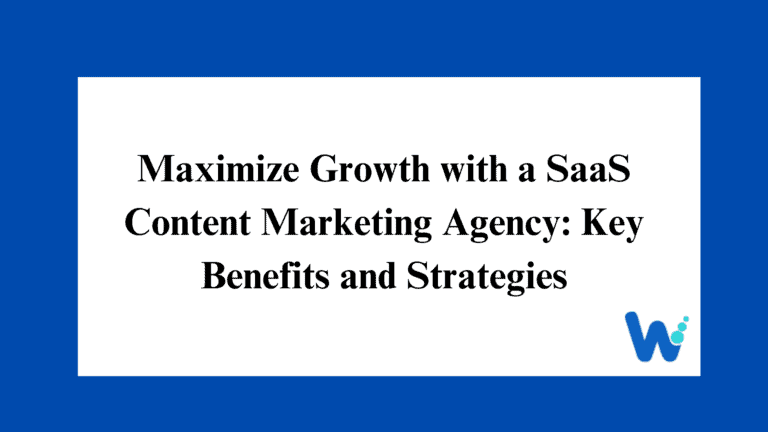Still juggling spreadsheets, manual follow-ups, and a website that looks like it was last updated in 2018? You’re not alone.
Most businesses say they’re “digital,” but behind the scenes, it’s chaos—scattered data, outdated processes, and content that doesn’t convert. The result? Missed leads, broken funnels, and teams that feel like they’re working harder, not smarter.
At Wordscloud, we believe content isn’t just part of digitization—it’s the engine behind it. Whether you’re a SaaS startup, a D2C brand, or a legacy enterprise, your digital transformation will stall without a solid content strategy.
This guide walks you through a 6-step, actionable roadmap to complete business digitization, with content placed where it belongs—at the very core.
Step 1: Assess Your Current Digital Maturity
Before you digitize, you need to diagnose. Businesses often rush into tech adoption without understanding their existing digital maturity. This leads to overlapping tools, inconsistent customer journeys, and poor ROI.
How to assess:
- Process Audit: Map out internal workflows—what’s manual, what’s semi-digital, and what’s already automated?
- Platform Review: Evaluate your tech stack. Are your CRM, CMS, analytics tools, and communication channels integrated?
- Customer Experience Check: Is your website intuitive? Can customers discover, engage, and convert smoothly?
- Digital Mindset Scan: Are your teams digitally literate? Is decision-making data-driven or instinct-led?
Quick Tip: Use a digital maturity model like the Deloitte Digital Maturity Index or PwC’s Digital IQ framework to benchmark your progress.
Step 2: Define Your Digital Goals (Not Just Your Tech Tools)
Digitization without direction is like buying gym equipment without a fitness goal.
Instead of asking “What tools should we use?”, ask:
- How can we shorten our sales cycle?
- How can we scale customer support without hiring more?
- How do we become a thought leader in our niche?
Set SMART digital goals:
- Increase lead-to-close rate by 30% in 6 months
- Reduce onboarding time by 40% with automated email flows
- Grow organic blog traffic by 5x through structured content
This is where content becomes a multiplier. Once your goals are clear, your content strategy becomes the bridge between tech adoption and business results.
Step 3: Centralize Customer & Business Data
Digitization thrives on data. But most businesses have fragmented datasets—leads in Excel sheets, campaigns in Mailchimp, chats in WhatsApp, and analytics in five different places.
Fix this with:
- CRM Platforms (e.g., HubSpot, Zoho, Salesforce): Centralize lead and customer data
- CDPs (Customer Data Platforms like Segment, mParticle): Unify behavioral, transactional, and demographic data
- Tag Managers & Pixels: Implement tools like GA4, Facebook Pixel, and LinkedIn Insights Tag to track user actions
- Dashboards: Visualize everything in one place using tools like Looker Studio, Power BI, or Metabase
This centralization helps content teams create personalized journeys—from lead nurturing emails to landing pages that convert like crazy.
According to McKinsey, companies that harness customer behavior data outperform peers by 85% in sales growth.
Step 4: Build a Scalable Content Engine
You’ve seen the phrase “content is king” thrown around. But here’s what it really means in the context of digitization:
Your tools, automation, and analytics are powerless unless they’re feeding into (and from) high-quality, consistent content. Content isn’t just what you say—it’s how you scale trust online.
Key content systems to build:
- Blog Strategy: Keyword clusters, SEO-friendly formats, internal linking, and monthly topic calendars
- Sales Enablement Content: Case studies, product one-pagers, and solution briefs
- Email Marketing Flows: Nurturing campaigns, onboarding sequences, re-engagement series
- Social Content: Multi-platform repurposing of blog snippets, founder stories, and user testimonials
- Landing Pages: Purpose-built for every campaign or audience segment
Outsource intelligently: You don’t have to build this machine alone. Agencies like Wordscloud offer plug-and-play content teams trained in SEO, technical writing, and conversion copy.
Step 5: Automate Key Processes (Marketing, Sales, Support)
Let’s face it—no team wants to manually send the same onboarding email 400 times or respond to “Is this in stock?” every morning.
Digitization’s biggest wins come from automation—but only when it enhances (not replaces) the customer experience.
Automation examples:
- Marketing: Auto-segment users by behavior, send drip email campaigns via ConvertKit or ActiveCampaign
- Sales: Route leads from landing pages directly into the CRM; trigger follow-up sequences
- Support: Use AI-powered bots (e.g., Tidio, Intercom) for common queries while escalating complex cases to humans
- Content Distribution: Schedule content on Buffer, auto-embed blogs into newsletters, or push webhooks from CMS to social
80% of top-performing companies use marketing automation to generate more leads (source: Invesp).
The best part? Automation amplifies the content you’ve already created, extending its reach and lifecycle without extra manual effort.
Step 6: Train, Test, and Continuously Iterate
Digitization is never “done.” Platforms evolve, customer expectations change, and what worked yesterday might flop tomorrow.
What to prioritize:
- Team Enablement: Train employees on using your digital systems. If your team doesn’t know how to use the CRM or analytics tool, it’s just another checkbox.
- Performance Reviews: Use KPIs tied to your content and digitization goals—traffic growth, CAC reduction, NPS, engagement rates
- A/B Testing: Especially for emails, CTAs, landing pages—test everything before scaling
- Quarterly Audits: Revisit your stack, workflows, and goals every 90 days to spot bottlenecks and tech debt
This stage is where content and analytics merge. Each iteration should be informed by what your audience actually consumes, clicks, and shares.
Why Content Is the Backbone of Digitization
Let’s be blunt—digitization without content is like a Ferrari with no fuel. It looks good, but it won’t take you anywhere.
Here’s how content powers each digitization pillar:
- Customer touchpoints? Content.
- Trust building? Content.
- SEO, social, email, PR? All content.
- Automation sequences? Content-led.
- Lead generation? Nothing without valuable content assets.
And in a post-cookie world, first-party content (blogs, newsletters, tools) is your most reliable growth channel.
Wordscloud specializes in content designed for the digital-first era. We help you:
- Build SEO authority with long-form blogs
- Educate your audience through whitepapers and guides
- Convert traffic with CRO-optimized landing pages
- Automate content distribution with repurposable formats
Final Thoughts: The New Playbook for Modern Businesses
Complete digitization isn’t about going viral on social or launching 20 tools in 20 days. It’s about building a unified, scalable, and sustainable system, with content holding it all together.
If you’re serious about transforming your business, you need:
- Strategic alignment
- Data centralization
- Automation
- And a rock-solid content engine
And if you need help getting started, Wordscloud is your content partner every step of the way.
Need a Scalable Content Engine for Your Digital Transformation?
We offer blog packages, technical content, product copy, and SEO strategies tailored for businesses going digital.
👉 Let’s build your content stack and scale your brand the right way.









